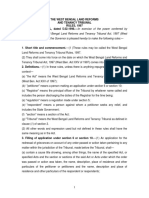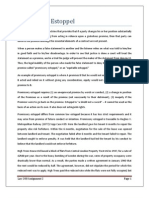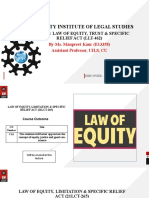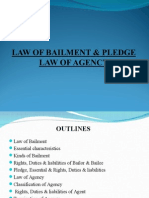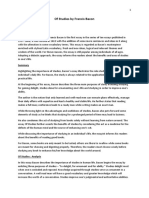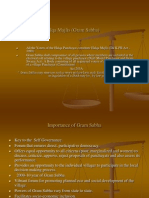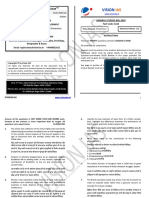0 ratings0% found this document useful (0 votes)
189 viewsDivide and Rule
Divide and Rule
Uploaded by
kiran shahzadiThe document discusses the formation of the All India Muslim League in 1906 and Britain's "divide and rule" strategy in India. It states that Britain began dividing Muslims and Hindus in the late 19th century in order to weaken opposition to British rule. In 1905, the partition of Bengal along religious lines was announced to give opportunities to Muslims and weaken Hindus. While the partition was rescinded in 1911, Britain continued its strategy of divide and rule, which led to the formation of the Muslim League in 1906 with the stated goal of promoting loyalty to Britain. The League initially consisted of wealthy Muslim landlords and supported British policies like the partition of Bengal.
Copyright:
Attribution Non-Commercial (BY-NC)
Available Formats
Download as DOC, PDF, TXT or read online from Scribd
Divide and Rule
Divide and Rule
Uploaded by
kiran shahzadi0 ratings0% found this document useful (0 votes)
189 views2 pagesThe document discusses the formation of the All India Muslim League in 1906 and Britain's "divide and rule" strategy in India. It states that Britain began dividing Muslims and Hindus in the late 19th century in order to weaken opposition to British rule. In 1905, the partition of Bengal along religious lines was announced to give opportunities to Muslims and weaken Hindus. While the partition was rescinded in 1911, Britain continued its strategy of divide and rule, which led to the formation of the Muslim League in 1906 with the stated goal of promoting loyalty to Britain. The League initially consisted of wealthy Muslim landlords and supported British policies like the partition of Bengal.
Copyright
© Attribution Non-Commercial (BY-NC)
Available Formats
DOC, PDF, TXT or read online from Scribd
Share this document
Did you find this document useful?
Is this content inappropriate?
The document discusses the formation of the All India Muslim League in 1906 and Britain's "divide and rule" strategy in India. It states that Britain began dividing Muslims and Hindus in the late 19th century in order to weaken opposition to British rule. In 1905, the partition of Bengal along religious lines was announced to give opportunities to Muslims and weaken Hindus. While the partition was rescinded in 1911, Britain continued its strategy of divide and rule, which led to the formation of the Muslim League in 1906 with the stated goal of promoting loyalty to Britain. The League initially consisted of wealthy Muslim landlords and supported British policies like the partition of Bengal.
Copyright:
Attribution Non-Commercial (BY-NC)
Available Formats
Download as DOC, PDF, TXT or read online from Scribd
Download as doc, pdf, or txt
0 ratings0% found this document useful (0 votes)
189 views2 pagesDivide and Rule
Divide and Rule
Uploaded by
kiran shahzadiThe document discusses the formation of the All India Muslim League in 1906 and Britain's "divide and rule" strategy in India. It states that Britain began dividing Muslims and Hindus in the late 19th century in order to weaken opposition to British rule. In 1905, the partition of Bengal along religious lines was announced to give opportunities to Muslims and weaken Hindus. While the partition was rescinded in 1911, Britain continued its strategy of divide and rule, which led to the formation of the Muslim League in 1906 with the stated goal of promoting loyalty to Britain. The League initially consisted of wealthy Muslim landlords and supported British policies like the partition of Bengal.
Copyright:
Attribution Non-Commercial (BY-NC)
Available Formats
Download as DOC, PDF, TXT or read online from Scribd
Download as doc, pdf, or txt
You are on page 1of 2
Formation of All India
Muslim League
• Critical View
The main instruments of British rule in India were the army and
the civil service. The Indian army was vital for both internal and
external reasons.
At the time of the mutiny the British army in India was made up of
34,000 Europeans and 257,000 Indians. Following the mutiny, the
proportion of Europeans was increased Attempts were made to
prevent the communal unity seen in 1857.
The tactic of dividing Muslims from Hindus began at the end of
the 19th century but crystallised further at the start of the 20th
century
In 1905 the British announced the partition of the province of
Bengal, justifying it on administrative grounds. Home secretary to
the government of India, H Risley, summed up his view:
Bengal united is a power; Bengal divided will pull in several
different ways...one of our main objects is to split up and thereby
weaken a solid body of opponents to our rule...A separate
administration, a separate high court and a separate university at
Dacca would give extra opportunities to the Muslim middle class
to emerge from their backward state and weaken the economic
base of the Hindu middle classes. The Hindu zamindari patrons to
the Congress would find the Muslim peasantry ranged against
them, secure in the support of the Dacca Secretariat. It would
divide the nationalist ranks once and for all.18
Britain was forced to rescind the partition of the province in 1911
to an avalanche of enthusiasm and rising national consciousness.
But it did not abandon its overall strategy of divide and rule. One
of the fruits of its manoeuvring was the formation of the Muslim
League in 1906. Its objectives included: 'to promote loyalty to the
British government, to protect and advance the political rights and
interests of Mussalmans of India and respectfully represent their
needs and aspirations to government'.19 The League began
declaring that the partition of Bengal was beneficial to Muslims, it
condemned agitation such as boycotts and it stressed the
contribution it could play in 'the defence of the empire'.20
The League was initially made up of the wealthy Muslim
landlords, mainly from the United Provinces in north India. Its
local bodies were headed by wealthy landlords or conservative
Muslim intellectuals.
The British extended the scope and nature of elections in 1909,
under the combined pressure of the movement from below and
their recognition of the need to win the cooperation of a larger
layer of Indians. At the same time they introduced one of the
League's most central demands: separate electorates for Muslims
and Hindus at the provincial level. It turned 'Muslim' and 'Hindu'
into political categories in a way they had not been before.
Income and educational qualifications for Muslim voters were
considerably lower than for other groups. And as the franchise
was slowly extended, politicians were encouraged to see
themselves as the representative of a particular group and to
court support on that basis.
You might also like
- Law of Equity Project Semester 10Document10 pagesLaw of Equity Project Semester 10debjit bhowmickNo ratings yet
- 005 - WBLRTT Rules 1997Document5 pages005 - WBLRTT Rules 1997Anonymous NARB5tVnNo ratings yet
- 2nd AssignmentDocument5 pages2nd AssignmentHassan_BIBM0% (1)
- Nara t733 r9 Guide 87Document143 pagesNara t733 r9 Guide 87Nikos SakellariouNo ratings yet
- The British Raj and India British Colonial InfluenDocument22 pagesThe British Raj and India British Colonial InfluenBalakrishna Gopinath100% (1)
- Reality of Divide and RuleDocument21 pagesReality of Divide and RuleRaja Mohan GopalakrishnanNo ratings yet
- The Growth and Impact of The East India Company On The Indian SubcontinentDocument20 pagesThe Growth and Impact of The East India Company On The Indian SubcontinentginukiggtNo ratings yet
- Shakespearean Comedy Features - Third Year-1Document3 pagesShakespearean Comedy Features - Third Year-1zyzz3690No ratings yet
- Rise of Nationalism in IndiaDocument34 pagesRise of Nationalism in IndiaRishabh BhandariNo ratings yet
- Formation of Muslim LeagueDocument3 pagesFormation of Muslim LeagueBabai KunduNo ratings yet
- Merchant of VeniceDocument2 pagesMerchant of VeniceSumeet ShindeNo ratings yet
- Declaration of IndependenceDocument3 pagesDeclaration of IndependenceKhadija SaeedNo ratings yet
- Vicarious LiabilityDocument4 pagesVicarious LiabilityNasreen HasanNo ratings yet
- Impact of British Rule Upsc Notes 74Document2 pagesImpact of British Rule Upsc Notes 74Abdullah FaizNo ratings yet
- Ram Mandir ProjectDocument12 pagesRam Mandir Projectgeceyi94450% (1)
- APSA Style Manual For Political Science Students (2006)Document50 pagesAPSA Style Manual For Political Science Students (2006)Richard RRPNo ratings yet
- Equity 2Document16 pagesEquity 2Harneet KaurNo ratings yet
- Emergence of Regional Powers CLASSDocument11 pagesEmergence of Regional Powers CLASSUjjwal DagarNo ratings yet
- History Assignment 2nd SemDocument9 pagesHistory Assignment 2nd SemAarya ChhanganiNo ratings yet
- Law of Bailment & PledgeDocument17 pagesLaw of Bailment & Pledgeswaroopd60% (1)
- Ted Hughes PoemsDocument9 pagesTed Hughes PoemsMadni Book DepotNo ratings yet
- Indian Council Act 1909Document2 pagesIndian Council Act 1909Maharshi BharaliNo ratings yet
- Exclusion of Mens Rea and Socio-Economic Offences in India - Law TeacherDocument8 pagesExclusion of Mens Rea and Socio-Economic Offences in India - Law TeachergurpreetsomalNo ratings yet
- Metaphysical Poetry PDFDocument37 pagesMetaphysical Poetry PDFPragya Dev100% (1)
- Harvard: OHN LIN Enter For AW Conomics AND UsinessDocument17 pagesHarvard: OHN LIN Enter For AW Conomics AND UsinessEnrique_CNo ratings yet
- Consitution - Meaning, Need, TypesDocument20 pagesConsitution - Meaning, Need, TypesJoseph MondomaNo ratings yet
- Unit 26 PDFDocument14 pagesUnit 26 PDFShanaya ThakurNo ratings yet
- Partition of BengalDocument32 pagesPartition of BengalBoishakhi SuhiNo ratings yet
- Law and Justice in Merchant of Venice 1Document11 pagesLaw and Justice in Merchant of Venice 1Akshansh BhadouriyaNo ratings yet
- Bacon - of StudiesDocument5 pagesBacon - of StudiesShivansh ChaudharyNo ratings yet
- English JurisprudenceDocument60 pagesEnglish JurisprudenceAhsan KhanNo ratings yet
- Administrative Law Project PDF 1Document29 pagesAdministrative Law Project PDF 1Ananya Rath100% (1)
- Tribunal 1889Document1 pageTribunal 1889Tom SnyderNo ratings yet
- I Have A Dream Martin Luther King Jr. Vocabulary WordsDocument10 pagesI Have A Dream Martin Luther King Jr. Vocabulary WordsRichelle Cayubit Dela Peña-LosdoNo ratings yet
- Jurisprudence Notes: Natural Law: Elise G. NalbandianDocument11 pagesJurisprudence Notes: Natural Law: Elise G. NalbandianUsha100% (1)
- Mr. Jinnah's Address To The Constituent Assembly of PakistanDocument6 pagesMr. Jinnah's Address To The Constituent Assembly of PakistanWaleed KhanNo ratings yet
- The River Merchant's Wife - PrintingDocument20 pagesThe River Merchant's Wife - PrintingbeevillafloresNo ratings yet
- Land Laws NOTEDocument59 pagesLand Laws NOTEAdv. Avilash TripathiNo ratings yet
- LAW 204 AssignmentDocument2 pagesLAW 204 AssignmentEfaz Mahamud AzadNo ratings yet
- R. W Emerson Self RelianceDocument2 pagesR. W Emerson Self RelianceRocío Santarossa CasadoNo ratings yet
- Social ProcessesDocument4 pagesSocial ProcessesSmile ChampNo ratings yet
- Uk Constitution and Sources NotesDocument11 pagesUk Constitution and Sources NotessamiaNo ratings yet
- Introduction Interpretation Construction IOSDocument10 pagesIntroduction Interpretation Construction IOSTANUNo ratings yet
- Falder Character PDFDocument3 pagesFalder Character PDFAtish BiswasNo ratings yet
- Banking LawDocument95 pagesBanking LawViraja GuruNo ratings yet
- Civil Law: The Term May Be Used in Two Senses. in One Sense It Indicates The Law ofDocument146 pagesCivil Law: The Term May Be Used in Two Senses. in One Sense It Indicates The Law ofAarav TripathiNo ratings yet
- Bible WordDocument7 pagesBible WordMaria Daniella Froilan100% (1)
- Forum Non ConveniensDocument3 pagesForum Non ConveniensYvonne GanNo ratings yet
- Role of Gram SabhaDocument12 pagesRole of Gram SabhaAyan NazirNo ratings yet
- Section 84Document16 pagesSection 84Bhuvaneswari Ram MotupalliNo ratings yet
- Khadraoui Amina PDFDocument50 pagesKhadraoui Amina PDFJyoti MalikNo ratings yet
- Law of AgencyDocument4 pagesLaw of Agencyummul93No ratings yet
- Types of Writs in IndiaDocument3 pagesTypes of Writs in IndiakaranNo ratings yet
- The Poison Tree NotesDocument4 pagesThe Poison Tree Notesvolverin77836No ratings yet
- Lord of The Flies William GoldingDocument5 pagesLord of The Flies William Goldingharoonali101325No ratings yet
- The American War of Independence 1776Document17 pagesThe American War of Independence 1776Tejasvi Nandagopal RaoNo ratings yet
- English Modernist Poetry - T.S. Eliot's The Waste Land: November 2017Document6 pagesEnglish Modernist Poetry - T.S. Eliot's The Waste Land: November 2017Themba ZunguNo ratings yet
- Contract Assignment 2020 PDFDocument10 pagesContract Assignment 2020 PDFSabrina CassandraNo ratings yet
- Land Administration In Urhobo Division Under Colonial Rule 1935 – 1960From EverandLand Administration In Urhobo Division Under Colonial Rule 1935 – 1960No ratings yet
- Early History and Pakistan MovementDocument31 pagesEarly History and Pakistan MovementShahriar HasanNo ratings yet
- Lecture 3Document15 pagesLecture 36pgztw57q7No ratings yet
- I Wandered Lonely As A Cloud: William WordsworthDocument1 pageI Wandered Lonely As A Cloud: William Wordsworthkiran shahzadiNo ratings yet
- Impact of Family Ownership On International Entrepreneurship Among Internationally Operating Firms in PakistanDocument2 pagesImpact of Family Ownership On International Entrepreneurship Among Internationally Operating Firms in Pakistankiran shahzadiNo ratings yet
- Introduction To Computing Asma ShaheenDocument16 pagesIntroduction To Computing Asma Shaheenkiran shahzadiNo ratings yet
- CH 1Document17 pagesCH 1kiran shahzadiNo ratings yet
- Law of Agency: Final ReportDocument31 pagesLaw of Agency: Final Reportkiran shahzadiNo ratings yet
- Week 2 Classical Political Theory and Modern Political TheoryDocument19 pagesWeek 2 Classical Political Theory and Modern Political TheoryHazel GasconNo ratings yet
- Vision: Innovative Assessment SystemDocument4 pagesVision: Innovative Assessment Systemanshul cheatNo ratings yet
- Legal MemorandumDocument4 pagesLegal Memorandumblocker6No ratings yet
- Ra 11926Document2 pagesRa 11926Roque LimNo ratings yet
- Civics Chapter 1st Answers Class 9thDocument2 pagesCivics Chapter 1st Answers Class 9thBISHALNo ratings yet
- 19 - PCFDocument2 pages19 - PCFMateo TVNo ratings yet
- Ra 8042 - RCG NotesDocument1 pageRa 8042 - RCG NotesroigtcNo ratings yet
- Washington Black LitChartDocument83 pagesWashington Black LitChartJeniNo ratings yet
- Indian Polity Complete BookletDocument398 pagesIndian Polity Complete BookletAjeet KumarNo ratings yet
- Our Lady of Lourdes Hospital v. Sps Capanzana, G.R. No. 189218, March 22, 2017Document34 pagesOur Lady of Lourdes Hospital v. Sps Capanzana, G.R. No. 189218, March 22, 2017Agent BlueNo ratings yet
- (Waalkes) Does Soccer Explain The WorldDocument16 pages(Waalkes) Does Soccer Explain The WorldJonathan AlfaNo ratings yet
- Executive OrderDocument2 pagesExecutive OrderAmaya LadiwanNo ratings yet
- Everyone Has A Right To ProtestDocument1 pageEveryone Has A Right To ProtestShivendra Singh ChauhanNo ratings yet
- Caste DiscriminationDocument2 pagesCaste DiscriminationMohana PriyaNo ratings yet
- Why A World State Is Inevitable: European Journal of International Relations 9Document2 pagesWhy A World State Is Inevitable: European Journal of International Relations 9Sofia Elizabeth TorresNo ratings yet
- The UK ConstitutionDocument43 pagesThe UK ConstitutionSafit100% (1)
- Feminism Life and Works of Rizal: Submitted To: Prof. Edwin Maestro Submitted By: Joy Pasco/3Edfil6ADocument16 pagesFeminism Life and Works of Rizal: Submitted To: Prof. Edwin Maestro Submitted By: Joy Pasco/3Edfil6AJoy PascoNo ratings yet
- LPU Presentation (CMTA, Feb 15, 2012)Document25 pagesLPU Presentation (CMTA, Feb 15, 2012)Jico Valguna BoneoNo ratings yet
- Samar II Electric Cooperative V SeludoDocument1 pageSamar II Electric Cooperative V SeludoMarvie Kate EncarnadoNo ratings yet
- 2020-08-27 Campos V Becerra Complaint (FULLY EXECUTED)Document31 pages2020-08-27 Campos V Becerra Complaint (FULLY EXECUTED)AmmoLand Shooting Sports NewsNo ratings yet
- Midterm His 103Document3 pagesMidterm His 103Rafsan JahangirNo ratings yet
- DND-IPMR MC-005 RESPECT AND PROTECT THE RIGHTS OF ICCs IPsDocument19 pagesDND-IPMR MC-005 RESPECT AND PROTECT THE RIGHTS OF ICCs IPsscoda.holywarriorsNo ratings yet
- Registration of Marriage PDFDocument4 pagesRegistration of Marriage PDFMd Aatif IqbalNo ratings yet
- Core FrameworkDocument14 pagesCore FrameworkAbdullah M. MacapasirNo ratings yet
- Activity2 Copyreading NSPCDocument7 pagesActivity2 Copyreading NSPCMarjorie Delrosario PilonNo ratings yet
- Gender and Music Gender Inequality and The Representation of Women in The Music IndustryDocument19 pagesGender and Music Gender Inequality and The Representation of Women in The Music IndustryFADWA TADISTNo ratings yet
- Brgy. Reso BirDocument2 pagesBrgy. Reso BirCazy Mel EugenioNo ratings yet
- TNPSC Group 1,2,4,8 VAO Preparation 1Document5 pagesTNPSC Group 1,2,4,8 VAO Preparation 1SakthiNo ratings yet

